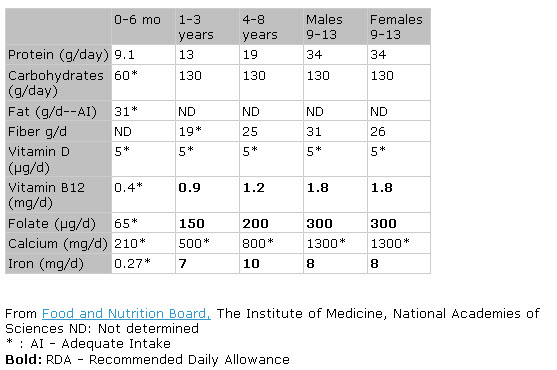GOOD NUTRITION
Good nutrition can be provided through a diet which includes all the substances necessary to sustain life and support growth without producing harm from excessive amounts of those substances. Variations in sources of nutrition will be better tolerated by some individuals than others. For example, a familial predisposition to hyperlipidemia and cardiovascular disease makes it imperative that some individuals limit intake of fats.
How much of certain nutrients does a person need to be healthy?
The standing Committee on the Scientific Evaluation of Dietary Reference Intakes of the Food and Nutrition Board, Institute of Medicine of the National Academies of Sciences has attempted to develop reference data regarding the amount of various nutrients needed by an apparently healthy general population. These recommendations are based on the following:
- nutrient balance studies
- nutrient intakes of breastfed infants and healthy adults
- biochemical measurement of tissue saturation or molecular function
- extrapolation from animal models
The Committee releases four Dietary Reference Intakes (DRI):
- Estimated Average Requirement
- Recommended Daily Allowance (RDA)
- Adequate Intake (AI) (If insufficient evidence is available to produce an RDA, an AI is reported instead.)
- Tolerable Upper Intake Level.
Age Variations
It is important to note that:
More on the Dietary Reference Intakes (DRI) for various nutrients vary by age, as is illustrated by the table below here.
DRI's by Age

- The recommended amounts of any given nutrient vary with age
- The recommended amounts of some nutrients are based upon expert estimate (AI) but lack definitive data
- No recommendations are available for some nutrients for small infants
- The needs of premature infants are not included in these recommendations, and in fact, vary considerably from those of term infants
- 1 µg cholecalciferol=40 IU Vitamin D
Dietary Guides
- The U.S. Department of Agriculture provides a reasonable dietary guide to the nutrition of children at Choose My Plate. Individualized dietary planning aides, appropriate for children and adults, are also available.
- Dietary Reference Intakes: A Risk Assessment Model for Establishing Upper Intake Levels for Nutrients, from Food and Nutrition Board or the Institute of Medicine
- website for educators, parents, and children from USDA




